Went to see the renown Takasaki Byakue Daikannon – or ‘Giant Takasaki White-Robed Kannon’, today. It is located on top of a small mountain, Mt Kanonyama in Gunma Prefecture and has an elevation of 190m. Colloquially it is called Kannonyama and sometimes they call it Byakui, and it is also known as the Goddess of Mercy… so I am just thinking of it as Kannon Of the Many Names! The Kannon (not the actual statue, but rather the concept of the Kannon), came originally from China where she is named, Guanyin, and people come to the Kannon to pray mostly for protection and peace, particularly for protection from natural disasters… which makes a lot of sense when you live on islands prone to volcanos, earthquakes and tsunamis.
The Kannon can be seen from quite a distance away as you approach as it is 41 metres tall on top of Mt Kannonyama. You can see the whole of Takasaki City proper in addition to all the most well-known mountains in Gunma from the top. You can go inside the Kannnon and climb up as high as its shoulders – there are nine floors inside that house 20 Buddhas along the climb.



The Byakue Daikanno was built by Yasuaburo Inoue in 1936, originally as a memorial for fallen soldiers of the Japanese Imperial Army who were stationed in Takasaki. It was always intended to eventually serve as a tourist attraction, and the promotion of the Kannon for tourism began as early as 1937. At that time it was the tallest Kannon in Japan, but has since been superseded by a number of other Kannon (the tallest is currently the Sendai Daikannon), and it is now the tenth tallest in Japan. At 41.8m tall, it has a 48m waist measurement and a 0.4m thumb circumference (though why tourists need to know that, I’m not sure!); she weighs a whopping 6000 tonnes.


Stunningly gorgeous day today. Blue skies, cool breeze, 20°C… just like a Brisbane winter!


We chose not to select some fortunes today… it looked like there was a lot of bad luck being left behind at this shrine! And I, for one, do not need any bad luck.



Every Valentines Day, a giant red string is tied around her finger and couples come to pray for blessings and happiness as well as longevity in their relationships.

Mr K looking chill under a Japanese maple tree… busy deciding how empty my cup is. Apparently, one shouldn’t remark on the fact that the maples haven’t turned this year and they should be bright orange by now, as this means your cup is half empty all the time. Le sigh… 🙄


Takasaki off in the distance there.

Around the base of the Kannon were some smaller shrines which (from what I could understand from the poorly translated signs) housed the graves/remains of much beloved temple authorities.



Nearby was the ubiquitous souvenir shop selling Daruma dolls. The Shorinzan Daruma-ji temple is nearby (and our next stop), so it’s not surprising to see them everywhere in Takasaki. The Daruma doll are a hollow, papier mache, round traditional doll modelled after Bodhidharma – the founder of the Zen tradition of Buddhism. Traditionally, they come in red and are designed to represent the Indian monk, Bodhidharma, but now they come in a wide range of colours and vary greatly in designs depending on regional variations and artistic interpretation. Lots of people consider the Daruma dolls to be a toy, but they are also believed to be a good luck talisman for many Japanese.

You can see in the images that the dolls have blank eyes – I’ll explain this a bit later below. The dolls have become a bit commercialised by many Buddhist temples and even co-opted by politicians as aspirational images for their campaigns. Now, you can buy your fav colour to meet your fav goal… vicarious airy-fairy meanings applied to each colour for the rose-quartz crowd.


This morning as we left the ryokan on our way to the Kannon, I had mentioned to Mr K that we may need to hunt down a supermarket to buy some Japanese pickles… generally speaking I abhor pickles (particularly American gherkins!) and other pickled things at home. Even in Japanese restaurants in Aust they are really ordinary, but here, they are so flavoursome and come in such varieties, that I wish we could get good quality Japanese pickles at home. Wouldn’t you know it? Mr K parks us to go visit the Kannon right beside “The Pickle House”… home to a wondrous selection of Japanese pickled EVERYTHING!

Well, once you are buying stuff that needs declaring at customs (something we usually avoid like the plague!), you may as well have STUFF to declare at customs! So in for a penny, in for a pound, I stocked up on pickles and am now free to peruse the Japanese marquetry too. Bonus! 😀 If we are going to be standing in the queue at Sydney Customs with pickles… may as well stand there for timber products too!




Just outside the pickle house was a steamed bun shop making miso steamed buns. Thankfully, they warned us that ’1 is cool for one person’, and as we were only after a wee snack, we decided to share a stick, rather than have one each. Delicious, burnt miso flavours; but rather starchy.

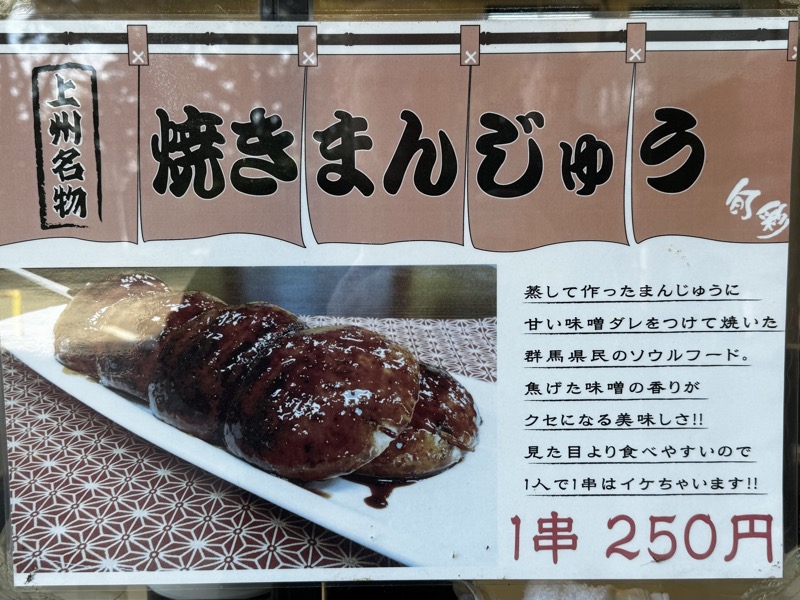
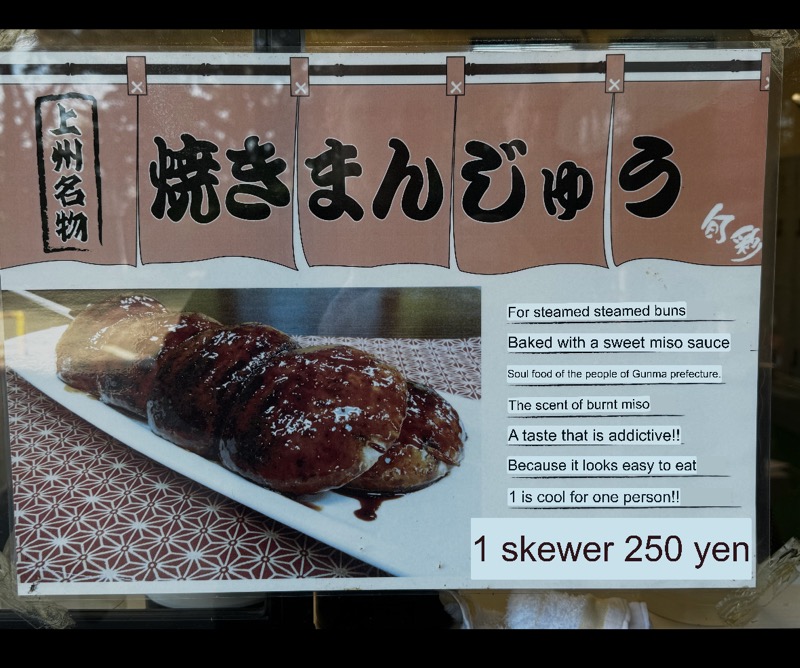

I loved this little guy on the bridge that crossed over the river to the temple area of town… good thing they don’t sell big stone painted Daruma like this one or I would want to take one home!

When we arrived at the Shorinzan Daruma Temple, the first thing that we were met by near the car park was a cemetery… complete with a little booth containing a sales representative that was ‘selling plots’. Hmmm… I’ve long been looking for a place to sprinkle my ashes, maybe this is the place! 🙂





The Shorinzan Daruma Temple is a small temple not far from the Kannon in Takasaki. It was built originally in 1697 but the Obaku Zen Buddhists as a school. It is known as the original birthplace of the Daruma and it is believed the original Daruma dolls came from this region. Legend has it that the Daruma of Shorinzan are especially lucky, so much so that the city of Takasaki has been leaning on that reputation and Takasaki is known as ‘The Lucky Town’.
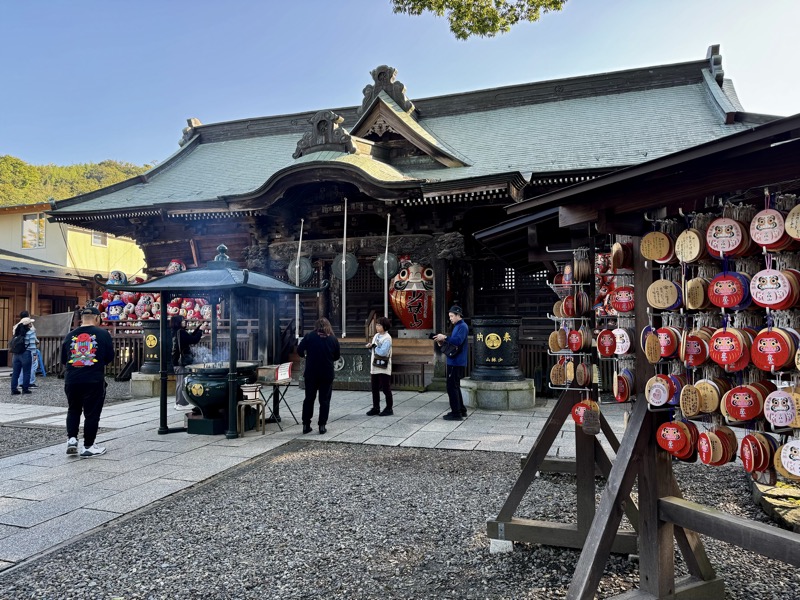
Originally the temple was believed to have been built for the Soto school of Zen Buddhism, but int he Meiji era was converted to the Obaku sect. In the late 18thC, the 9th generation Zen Master of the temple offered aid and comfort during the Great Tenmei famine, for whatever reasons, he taught them how to make papier-mache dolls based on the Daruma dolls. These become known as the Shorinzan Nanakusa Taisai Daruma Market Festival which is held every January. In more recent years, the festival has attracted thousands of visitors who come to buy new Daruma dolls and burn their old ones as offerings.

The Daruma dolls are often associated with the phrase, ‘Nanokorobi yaoki’, which means: ‘seven times down, eight times up’, which speaks to the resilience of the dolls – the Daruma are light due to their papier-mache construction, but they are weighted in the bottom so they always bounce back up to an upright position when they are tilted or rocked over. In Japan, these are called ‘okiagari’, which means to get up (oki) and rise (agari). They symbolise the ability to overcome adversity and recover from falls or find success and uprightness.



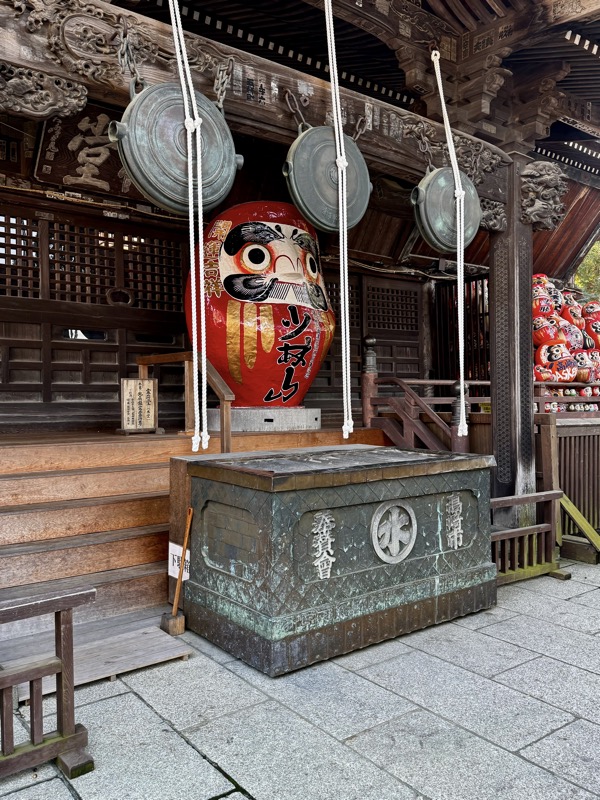



The eyes of the Daruma are often blank when people buy them. They have large oversized symmetrical round white eyes. The purchaser is encouraged to paint in one of the eyes, and focus on a goal. The aim is to complete the next eye when one meets the goal or finishes the big task in mind. They are commonly given as gifts at the beginning of the year or to students, and the recipient of the doll will fill in one eye upon setting their goals, then the other upon fulfilling it. This way, every time they see the one-eyed Daruma, they remember the goal and hopefully work towards it… steadfastly in spite of possible setbacks.

When dolls have both their eyes filled in, marking the completion of one’s goals, some people return them to the Shorinzan Daruma-ji Temple… hence the large collection here at any given point in time. (I wonder if they are cleaned out once a month, like locks on a Florentine bridge or coins from the Trevi Fountain).




After the temple visit we stopped at a konbini to grab some saké and beers – as you do! And I was curious to know what was in these steamed buns… gotta love Google Translate. It comes up with some real corkers.


Another quick and accessible sight in the Takasaki area are the Doukutsu Kannon Caves. These are a 450m deep man-made cave system that have 39 statues of the Kannon Goddess of Mercy on display. Each piece of sculpture is an artwork by the sculptor Rakuzan who devoted his life to creating this unique gallery. The caves appear to be a philanthropic project of a wealthy kimono maker and trader named Tokuzo Yamada. He was apparently quite generous with his fortune and spent half his life on this huge undertaking with the goal of making Takasaki a pilgrimage destination, such that visiting the Doukutsu Kannon would confer upon visitors the same blessings as visiting prestigious temples.



Tokuzo was reputed to have been quite knowledgeable in the design fields and was heavily involved in the layout and design of the Doukutsu Kannon statues he commissioned from teh sculptor Rakuzan. The statues and their posture and clothing are very similar to the aesthetic used in Buddhist art to this day. The entire cave system is considered a masterpiece of modern Buddhist art.

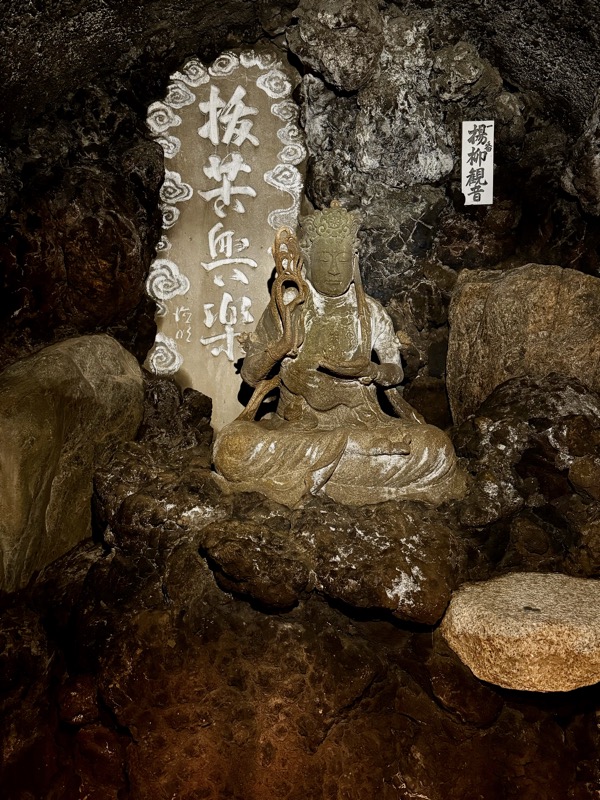


Usually depictions of the Buddhist goddess, Kannon will depict her with a varying background – among rocks, waterfalls, upon mountains, in the snow…. the Doukutsu Kannon created by Rakuzan and Tokuzo are the only Buddhist artworks where the ‘world of the gods is made real’. That is the backgrounds are created by using materials like local Gunma Prefecture volcanic rock and Sanbaseki stone, to create entire environments to glorify the Kannon.


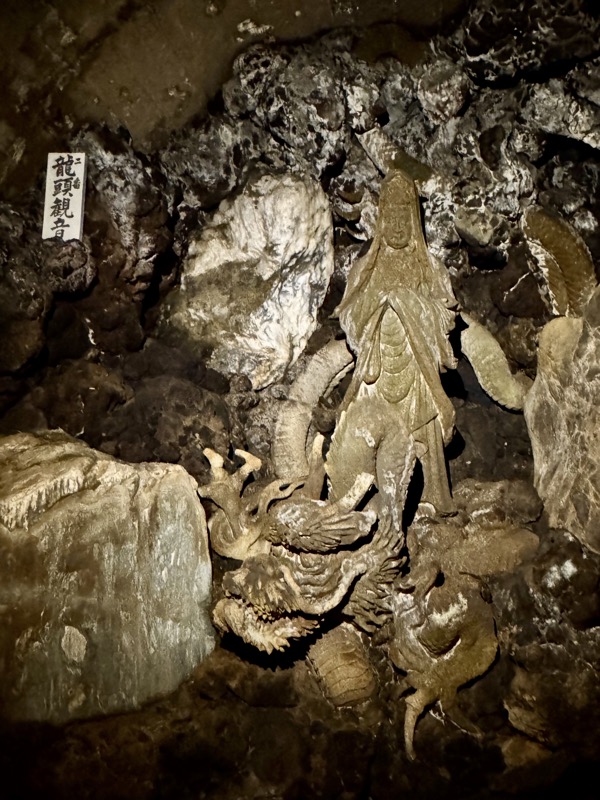


Some of the statues and their vignettes are said to have take the artist more than a year to create.






The work on the caves and their artworks continued until Tokuzo passed away in 1964. The goal had been to make a 800m deep cave, but encountered limitations when they discovered hard ground, which hindered the continuation of the project. They current walk through the caves is 450m and is completely accessible… very unusually for a manmade cave system, it has not steps, but rather is cut into an existing mountain.


This wall may exemplify the difficulty that was found with the tunnelling project.




Right by the caves are the Tokumeien Gardens – considered one of the best Japanese gardens in the northern Kanot region and covering a 20,000sqm area. It is built on the slopes of the Kannonyama Hill using a large amount of the of rocks, soil and sand that were excavated during the creation of the cave.


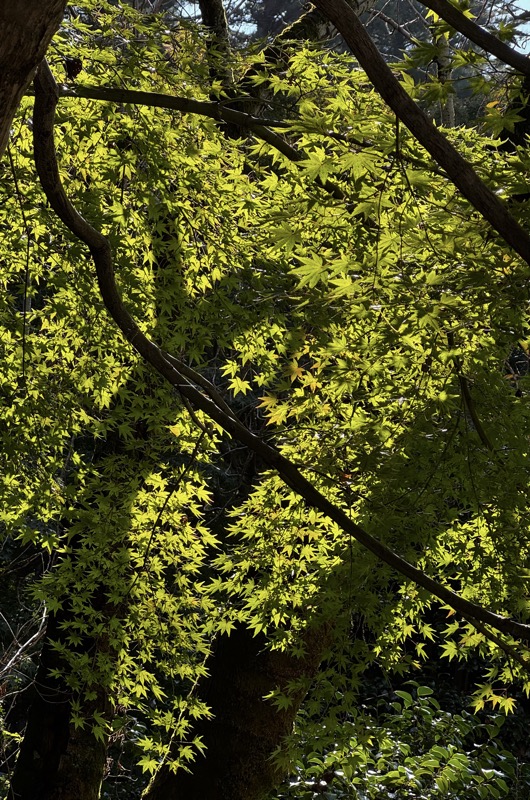

The garden was designed by Yamada Tokuzou and the master Japanese architect, Kaneko Seikichi. The landscaping was completed by Goto Sekisui II, who was also involved in the beautiful gardens surrounding the Meiji Shrine in Tokyo.


The garden is a beautiful relaxing space filled with giant Sanbaishi stones, a huge amount of lava stones transported from Mt Asmara, red pines, Niigata black pines, and seasonal plants.



Sadly, the autumn foliage is late this year – like, concerningly late. The predictions have been put down to a particularly hot and unusually long summer. The tourism industry each year tries to predict the turning of the leaves in Japan, much like they do for the sakura – cherry blossom season, but thanks to climate change it is getting harder and harder to predict.



The garden should have been full of deep orange and red colour at this time of year, but hardly any of the leaves have turned at all. I have heard news reports that the tourism industry is fearing that the leaves won’t turn at all, but that the weather will turn cold so quickly, the leaves will simply fall dead from the trees rather than give the month long colour people come to see.


The gardens were lovely – though unfortunately, not the vibrant colour way that you can normally expect in November. Below, November pic of the gardens stolen from the internet:


After this we opted for a quickie late lunch. Now, we have been in Japan a number of times, but have never been to a regular ol’ sushi train. So we thought we seek one out. Kura-Sushi is a reliable and well known chain across Japan.

It was exactly what we were expecting! Fantastic (and cheap!) food, quick service, hardly any interactions with the staff at all. It was also super noisy because today was Culture Day, which is a public holiday, and there seemed to be lots of families out who would probably normally at school and work. Was good fun though; I’d go again… lunch for two including drinks was barely AUD$30, and we were trying all the strange things on the menu.



Not a bad morning out – now back to work!







































